歓待の共同体としての大学
Quo Vadis, Vniuersitatis
歓待の共同体としての大学
Quo Vadis, Vniuersitatis
「使徒ヨハネ」の福音書には、「初めに言葉ありき」 という不思議な言挙げに始まり、他の3つの福音書——文言に共通点が多いのでマタイ、マルコ、ルカを共観福音書という——にはない、イエスの言葉をより多 く伝え、「神は愛」というスローガンでイエスの教えを今日に端的に伝え、生前のイエスの奇跡の行状がヴィヴィッドに描かれるなど独特の雰囲気がある。ヨハ ネはイエスが処刑される時に唯一立会い、「最も愛された弟子」と言われた。手紙の結びの言葉に、神とペンではすべてを伝えることはできず、本当はもっと親 しく話し合いたいと書く、元祖コミュニケーション派の使徒でもあった。
ヨハネの福音書が唯一伝える有名なシーンがある。最 後の晩餐の前に、弟子たちが恐縮して遠慮することを諌めてイエスは積極的に彼らの足を洗う。足を洗った後に「私はお前たちの先生だ」と弟子に呼びかける。 そして先生が弟子におこなったことを、今度は弟子同士で互いに足を洗う、つまり、お互いに愛し合い、歓待すべきだと垂範する。イエスは弟子たちを慈しむこ とを通して、今度は、その慈しみを君の弟子に分かち合うことの重要性を述べる。さて、イエスとその弟子たちは今でいう新興宗教の教祖とウルトラマイナーな 数少ない弟子たちである。いつも腹をすかして布教の途に就いていた。しかし、どんな身分の人にも真摯に対話をしようとするイエスに魅入られた人は、貧しい なけなしの食料と酒を提供して、イエスの話に耳を傾ける。師匠と弟子たちは大食らいだとも記される。初期の布教の姿を描いた図像には、横になってくつろい で会食する師匠と弟子たちの姿が描かれている(ルドルフスキー『さあ横になって食べよう』鹿島出版会、1999)。イエスと使徒たちの情熱を支えていたの は、彼らを歓待したのは貧しく、清らかな生活を送っていた市井の人たちだ。当時の宗教界の長老や権力者は、このようなアナーキーなカルト集団の活動を異端 視し、監視し、そして捕縛、審問しようとする。その度に、パトロンに対して礼を言い、イエスと弟子たちはそそくさと出奔する(Quo vadis, nōbīs? )。よい教えをより多くの人に伝えるためには、このような逃走は意味 のある行動になっていた。
僕たちの大学では、学生に教室に居続け教員の話に耳 を傾け、図書館で本を読み、フィールドデータをパソコンに入力し、研究論文を書いて、学友よりもよりよい成績を残して、キャンパスから旅立ち、立派な社会 人になれと訓育する。しかし、これはイエスが弟子たちに言った、厄介な迫害者には逃 げることが一番だと いう教えとは真逆である。矛盾や厄介なことに出会ったらとにかく辛抱して続けることが重要だというのがキャンパスの掟だとすると、イエスの教えは、困難な ことに直面したらそこから一度退き、再挑戦のために戦力を温存せよということだ。逃げてこそはじめて、態勢を取り戻して復活することができる。今日の大学教授に、道行きで泥にまみれた弟子たちの足を洗い、歓待(=心温まる教育)した上 で、同じことを後輩におこなうべきだ、自ら垂範する者はいるだろうか? 厄介だからここはひとまず一緒に逃げるとするか!という先生はいるか? 僕が理 想とする大学が、先生と弟子たちの真の友愛の共同体になるためには、まだまだ幾多の課題があるように思える。
——シモン・ペテロがイエスに言った、「主よ、どこへおいでになるのですか(Quo vadis, Domine? )」。 イエスは答えられた、「あなたはわたしの行くところに、今はついて来ることはできない。しかし、あとになってから、ついて来ることになろう」。 ペテロはイエスに言った、「主よ、なぜ、今あなたについて行くことができないのですか。あなたのためには、命も捨てます」。 イエスは答えられた、「わたしのために命を捨てると言うのか。よくよくあなたに言っておく。鶏が鳴く前に、あなたはわたしを三度知らないと言うであろう」 (ヨハネ福音書 13:36-38)。
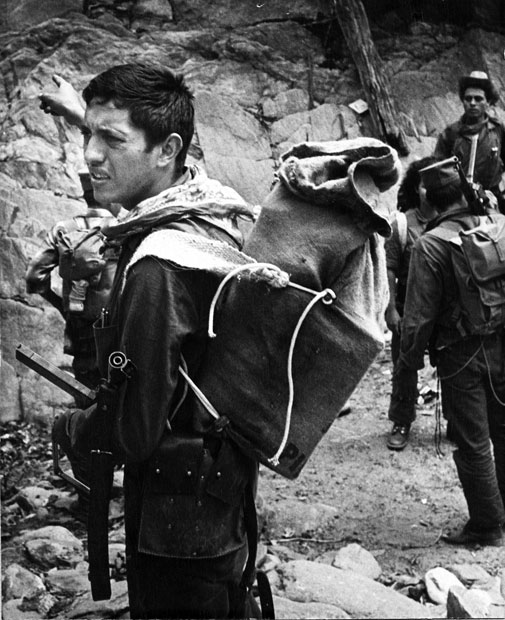
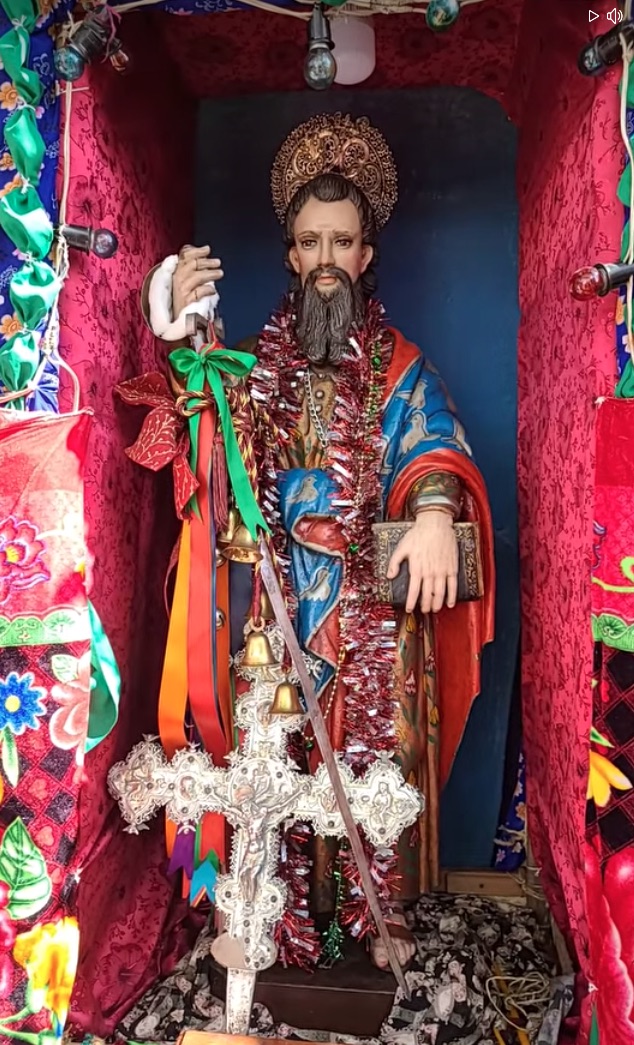
Quo vadis, guerrillero? El Movimiento Rebelde 13 de Noviembre (MR13) y el surgimiento de la lucha armada en Guatemala, ca.1962.
★最後の晩餐
キリスト教美術における最後の晩餐の描写は、何世紀にもわたって芸術の巨匠た
ちによって描かれてきた。レオナルド・ダ・ヴィンチが1490年代後半にイタリアのミラノに描いた壁画が最もよく知られた例である。
| The Last Supper
is the final meal that, in the Gospel accounts, Jesus shared with his
apostles in Jerusalem before his crucifixion.[2] The Last Supper is
commemorated by Christians especially on Holy Thursday.[3] The Last
Supper provides the scriptural basis for the Eucharist, also known as
"Holy Communion" or "The Lord's Supper".[4] The First Epistle to the Corinthians contains the earliest known mention of the Last Supper. The four canonical gospels state that the Last Supper took place in the week of Passover, days after Jesus's triumphal entry into Jerusalem, and before Jesus was crucified on Good Friday.[5][6] During the meal, Jesus predicts his betrayal by one of the apostles present, and foretells that before the next morning, Peter will thrice deny knowing him.[5][6] The three Synoptic Gospels and the First Epistle to the Corinthians include the account of the institution of the Eucharist in which Jesus takes bread, breaks it and gives it to those present, saying "This is my body given to you".[5][6] The Gospel of John tells of Jesus washing the feet of the apostles,[7] giving the new commandment "to love one another as I have loved you",[8] and has a detailed farewell discourse by Jesus, calling the apostles who follow his teachings "friends and not servants", as he prepares them for his departure.[9][10][11] Some scholars have looked to the Last Supper as the source of early Christian Eucharistic traditions.[12][13][14][15][16][17] Others see the account of the Last Supper as derived from 1st-century eucharistic practice as described by Paul in the mid-50s.[13][18][19][20] |
最後の晩餐は、福音書の記述では、イエスが十字架にかけられる前にエル
サレムで使徒たちと分かち合った最後の食事である。最後の晩餐は、特に聖木曜日にキリスト教徒によって記念される。最後の晩餐は、"聖餐 "または
"主の晩餐 "とも呼ばれる聖体の聖典的根拠となる。 『コリントの信徒への手紙一』には、最後の晩餐に関する最古の記述がある。四つの正典福音書によれば、最後の晩餐は過越の祭りの週に行われ、イエスがエル サレムに凱旋した数日後、聖金曜日にイエスが十字架につけられる前に行われた。食事中、イエスはその場にいた使徒の一人に裏切られることを予言し、翌朝ま でにペテロが三度イエスを知らないと否定することを予告した。 3つの共観福音書とコリントの信徒への第一の手紙には、イエスがパンを取り、それを裂き、「これはあなたがたに与えられるわたしの体である」と言ってその 場にいる人々に与える聖体授与の記述がある。ヨハネによる福音書では、イエスが使徒たちの足を洗い、「わたしがあなたがたを愛したように、互いに愛し合い なさい」という新しい戒めを与え、イエスの教えに従う使徒たちを「しもべではなく友」と呼び、イエスの旅立ちに備えるイエスの別れの講話が詳しく書かれて いる。 初期キリスト教の聖体の伝統の源流として、最後の晩餐に注目する学者もいる。また、最後の晩餐の記述は、50年代半ばにパウロによって記述された1世紀の 聖体礼儀の習慣に由来すると考える学者もいる。 |
Terminology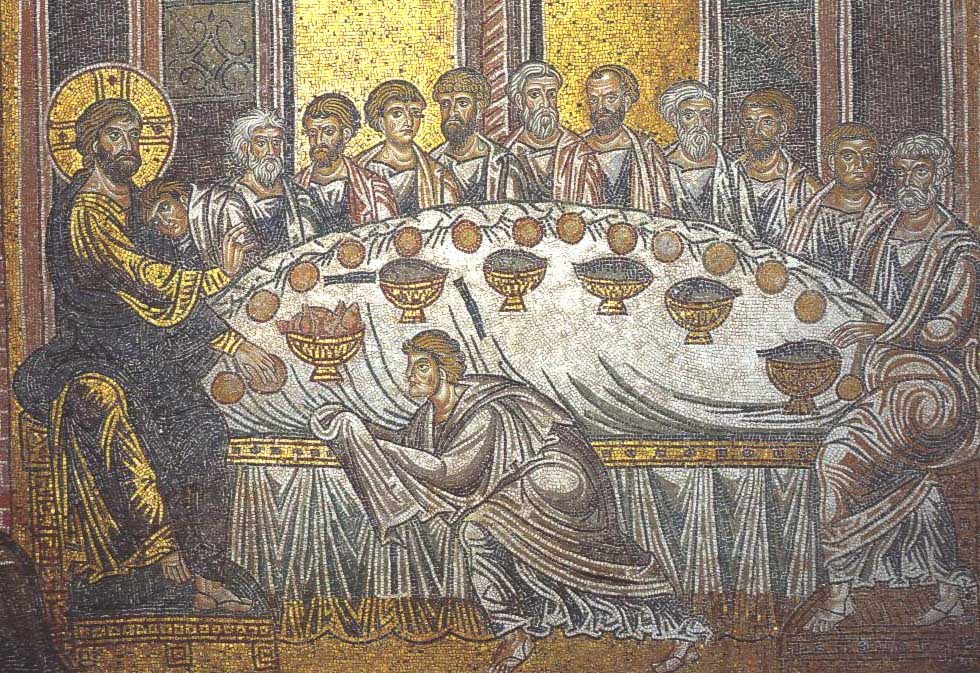 Last Supper, Monreale Cathedral mosaics (Palermo, Sicily, Italy) The term "Last Supper" does not appear in the New Testament,[21][22] but traditionally many Christians refer to such an event.[22] The term "Lord's Supper" refers both to the biblical event and the act of "Holy Communion" and Eucharistic ("thanksgiving") celebration within their liturgy. Evangelical Protestants also use the term "Lord's Supper", but most do not use the terms "Eucharist" or the word "Holy" with the name "Communion".[23] The Eastern Orthodox use the term "Mystical Supper" which refers both to the biblical event and the act of Eucharistic celebration within liturgy.[24] The Russian Orthodox also use the term "Secret Supper" (Church Slavonic: "Тайная вечеря", Taynaya vecherya). |
用語解説 最後の晩餐、モンレアーレ大聖堂のモザイク(イタリア、シチリア島、パレルモ) 最後の晩餐」という用語は新約聖書には登場しないが[21][22]、伝統的に多くのキリスト教徒がそのような出来事を指している[22]。福音派のプロ テスタントも「主の晩餐」という用語を使用するが、ほとんどのプロテスタントは「聖体」という用語や「聖体」という単語を「聖餐式」という名称と共に使用 しない[23]。 東方正教会は「神秘の晩餐」という用語を使用するが、これは聖書の出来事と典礼の中での聖体祭儀の行為の両方を指す。ロシア正教徒は「秘密の晩餐」(教会 スラヴ語: Тайная вечеря, Taynaya vecherya)という用語も用いる。 |
| Scriptural basis The last meal that Jesus shared with his apostles is described in all four canonical Gospels[25] as having taken place in the week of the Passover. This meal later became known as the Last Supper.[6] The Last Supper was likely a retelling of the events of the last meal of Jesus among the early Christian community, and became a ritual which recounted that meal.[26] Paul's First Epistle to the Corinthians,[27] which was likely written before the Gospels, includes a reference to the Last Supper but emphasizes the theological basis rather than giving a detailed description of the event or its background.[5][6] Background and setting 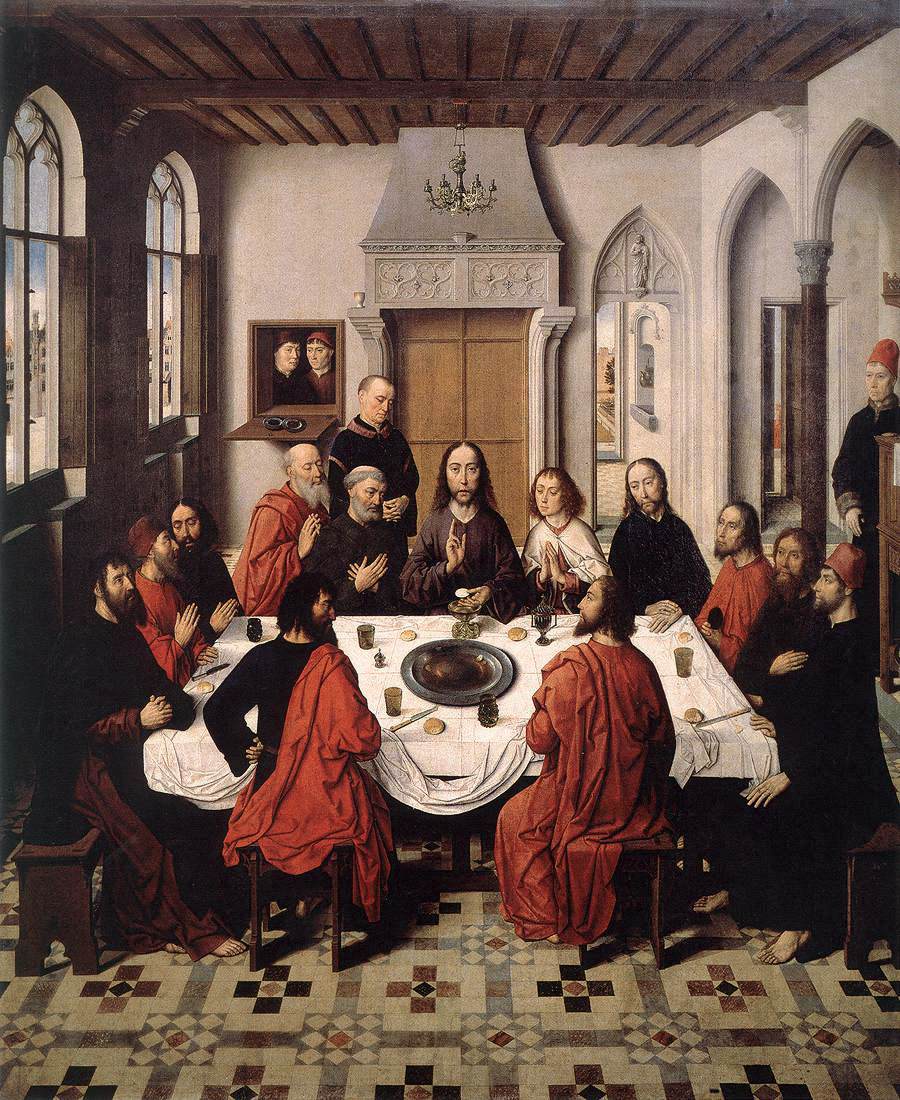 The Last Supper by Dieric Bouts The overall narrative that is shared in all Gospel accounts that leads to the Last Supper is that after the triumphal entry into Jerusalem early in the week, and encounters with various people and the Jewish elders, Jesus and his disciples share a meal towards the end of the week. After the meal, Jesus is betrayed, arrested, tried, and then crucified.[5][6] Key events in the meal are the preparation of the disciples for the departure of Jesus, the predictions about the impending betrayal of Jesus, and the foretelling of the upcoming denial of Jesus by Apostle Peter.[5][6] Prediction of Judas' betrayal Main article: Jesus predicts his betrayal In Matthew 26:24–25, Mark 14:18–21, Luke 22:21–23 and John 13:21–30, during the meal, Jesus predicted that one of the apostles present would betray him.[28][29] Jesus is described as reiterating, despite each apostle's assertion that he would not betray Jesus, that the betrayer would be one of those who were present, and saying that there would be "woe to the man who betrays the Son of man! It would be better for him if he had not been born."[30] In Matthew 26:23–25 and John 13:26–27, Judas is specifically identified as the traitor.[31] In the Gospel of John, when asked about the traitor, Jesus states: "It is the one to whom I will give this piece of bread when I have dipped it in the dish." Then, dipping the piece of bread, he gave it to Judas, the son of Simon Iscariot. As soon as Judas took the bread, Satan entered into him. — Evans 2003, pp. 465–477 Fahlbusch 2005, pp. 52–56 |
聖書の根拠 イエスが使徒たちと分かち合った最後の食事は、4つの福音書[25]すべてに過越の祭りの週に行われたと記述されている。この食事は後に最後の晩餐として 知られるようになった[6]。最後の晩餐は、おそらく初期キリスト教共同体の間でイエスの最後の食事の出来事が語られ、その食事を再現する儀式となった [26]。 福音書よりも前に書かれたと思われるパウロの『コリントの信徒への手紙一』[27]には、最後の晩餐についての言及があるが、その出来事や背景についての 詳細な記述はなく、神学的な根拠が強調されている[5][6]。 背景と設定  ディエリック・ブーツ作『最後の晩餐』 すべての福音書に共通する最後の晩餐に至る全体的な物語は、週の初めにエルサレムに凱旋し、様々な人々やユダヤ人の長老たちと出会った後、週の終わりにイ エスと弟子たちが食事を共にするというものである。食事の後、イエスは裏切られ、逮捕され、裁判にかけられ、そして十字架にかけられる[5][6]。 食事の中で重要な出来事は、イエスの旅立ちに対する弟子たちの準備、差し迫ったイエスの裏切りについての予言、使徒ペテロによる来るべきイエスの否定の予 言である[5][6]。 ユダの裏切りの予言 主な記事 イエスの裏切り予言 マタイによる福音書26:24-25、マルコによる福音書14:18-21、ルカによる福音書22:21-23、ヨハネによる福音書13:21-30にお いて、イエスは食事の間に、その場にいた使徒の一人がイエスを裏切ることを予言した。 28][29] イエスは、自分はイエスを裏切らないと各使徒が主張しているにもかかわらず、裏切る者はその場にいた者の一人であると繰り返し、「人の子を裏切る者には災 いがある!人の子を裏切る者に災いあれ。生まれて来なかった方が、その人のためである」[30]。 マタイによる福音書26:23-25とヨハネによる福音書13:26-27では、ユダは裏切り者として具体的に特定されている[31]。 ヨハネによる福音書では、裏切り者について尋ねられたとき、イエスはこう述べている: 「それは、わたしがこのパンを皿に浸したとき、わたしがこのパンを与える者である」。そして、パンを浸して、イスカリオテのシモンの子ユダに渡した。ユダ がパンを受け取るとすぐに、サタンがユダの中に入り込んだ。 - エヴァンス 2003, 465-477 頁 ファールブッシュ 2005, 52-56 頁 |
| Institution of the Eucharist The three Synoptic Gospel accounts describe the Last Supper as a Passover meal,[32][33] disagreeing with John.[33] Each gives somewhat different versions of the order of the meal. In chapter 26 of the Gospel of Matthew, Jesus prays thanks for the bread, divides it, and hands the pieces of bread to his disciples, saying "Take, eat, this is my body." Later in the meal Jesus takes a cup of wine, offers another prayer, and gives it to those present, saying "Drink from it, all of you; for this is my blood of the covenant, which is poured out for many for the forgiveness of sins. I tell you, I will never again drink of this fruit of the vine until that day when I drink it new with you in my Father's kingdom." In chapter 22 of the Gospel of Luke, however, the wine is blessed and distributed before the bread, followed by the bread, then by a second, larger cup of wine, as well as somewhat different wordings. Additionally, according to Paul and Luke, he tells the disciples "do this in remembrance of me." This event has been regarded by Christians of most denominations as the institution of the Eucharist. There is recorded celebration of the Eucharist by the early Christian community in Jerusalem.[10] The institution of the Eucharist is recorded in the three Synoptic Gospels and in Paul's First Epistle to the Corinthians. As noted above, Jesus's words differ slightly in each account. In addition, Luke 22:19b–20 is a disputed text which does not appear in some of the early manuscripts of Luke.[34] Some scholars, therefore, believe that it is an interpolation, while others have argued that it is original.[35][36] A comparison of the accounts given in the Gospels and 1 Corinthians is shown in the table below, with text from the ASV. The disputed text from Luke 22:19b–20 is in italics. |
聖体の授与 共観福音書の3つの記述は、最後の晩餐を過越の食事として記述しており[32][33]、ヨハネとは異なっている[33]。マタイによる福音書の第26章 では、イエスはパンに感謝して祈り、パンを分け、弟子たちにパンのかけらを手渡し、"取りなさい、食べなさい、これはわたしのからだである "と言う。食事の後、イエスはぶどう酒の杯を取り、もう一度祈りをささげ、その場にいる人々に渡して言われた。あなたがたに言っておくが、私の父の王国 で、あなたがたとともにこのぶどうの実を新たに飲むその日まで、私は二度とこのぶどうの実を飲むことはない。" しかし、ルカによる福音書22章では、パンの前にぶどう酒が祝福され、配られ、パンの後に2杯目の大きなぶどう酒が配られ、言葉も多少異なっている。さら に、パウロとルカによれば、弟子たちに "わたしを思い起こしてこれを行いなさい "と告げている。この出来事は、ほとんどの宗派のキリスト教徒によって、聖体の制定とみなされてきた。エルサレムの初期キリスト教共同体が聖体を祝ったと いう記録もある[10]。 聖体の授与は、3つの共観福音書とパウロのコリント人への第一の手紙に記録されている。上述のように、イエスの言葉はそれぞれの記述でわずかに異なってい る。加えて、ルカによる福音書22:19b-20は、ルカによる福音書の初期の写本のいくつかには出てこない、論争の的になっているテキストである [34]。それゆえ、ある学者はこのテキストは補筆であると信じているが、他の学者はオリジナルであると主張している[35][36]。 福音書とコリントの信徒への手紙一の記述の比較は、ASVのテキストとともに以下の表に示されている。ルカによる福音書22:19b-20の論争中のテキ ストは斜体で示されている。 |
| Mark 14:22–24 And as they were eating, he took bread, and when he had blessed, he brake it, and gave to them, and said, Take ye: this is my body. And he took a cup, and when he had given thanks, he gave to them: and they all drank of it. And he said unto them, 'This is my blood of the covenant, which is poured out for many.'[37] |
マルコ14:22-24 そして, 彼らが食べているとき, パンを取り, 祝福してから, それを裂き, 彼らに与えて言われた, 「取りなさい, これはわたしのからだである」. そして杯を取り、感謝をささげてから彼らに与えた。そして彼らに言われた,『これは多くの人のために注がれるわたしの契約の血である』」[37]。 |
| Matthew 26:26–28 And as they were eating, Jesus took bread, and blessed, and brake it; and he gave to the disciples, and said, 'Take, eat; this is my body.' And he took a cup, and gave thanks, and gave to them, saying, 'Drink ye all of it; for this is my blood of the covenant, which is poured out for many unto remission of sins.'[38] |
マタイ26:26-28 彼らが食事をしていると、イエスはパンを取り、祝福して裂かれた。 また,杯を取って感謝し,彼らに与えて言われた,『これをみな飲みなさい。これは,罪の赦しのために多くの人のために注がれるわたしの契約の血である』」 [38]。 |
| 1 Corinthians
11:23–25 For I received of the Lord that which also I delivered unto you, that the Lord Jesus in the night in which he was betrayed took bread; and when he had given thanks, he brake it, and said, 'This is my body, which is for you: this do in remembrance of me.'[39] In like manner also the cup, after supper, saying, 'This cup is the new covenant in my blood: this do, as often as ye drink it, in remembrance of me.' |
第一コリント11:23-25
主イエスが裏切られた夜,パンを取り,感謝をささげてから,それを裂き,『これは,あなたがたのためにあるわたしのからだである。 この杯は、わたしの血による新しい契約であり、あなたがたが飲むたびに、わたしを思い起こしてこれを行いなさい』。 |
| Luke 22:19–20 And he took bread, and when he had given thanks, he brake it, and gave to them, saying, 'This is my body which is given for you: this do in remembrance of me.'[40] And the cup in like manner after supper, saying, 'This cup is the new covenant in my blood, even that which is poured out for you.' |
ルカ 22:19-20 そして、パンを取り、感謝をささげてから、それを裂き、彼らに与えて言われた、『これは、あなたがたのために与えられるわたしのからだである。 晩餐の後、同じようにこう言った、「この杯は、わたしの血による新しい契約であり、あなたがたのために注がれるものである」。 |
| Jesus' actions in sharing the
bread and wine have been linked with Isaiah 53:12[41] which refers to a
blood sacrifice that, as recounted in Exodus 24:8,[42] Moses offered in
order to seal a covenant with God. Some scholars interpret the
description of Jesus' action as asking his disciples to consider
themselves part of a sacrifice, where Jesus is the one due to
physically undergo it.[43] Although the Gospel of John does not include a description of the bread and wine ritual during the Last Supper, most scholars agree that John 6:58–59[44] (the Bread of Life Discourse) has a Eucharistic nature and resonates with the "words of institution" used in the Synoptic Gospels and the Pauline writings on the Last Supper.[45] |
パンとぶどう酒を分かち合うイエスの行為は、出エジプト記24:8
[42]に記されているように、モーセが神との契約を結ぶために捧げた血のいけにえに言及しているイザヤ書53:12[41]と関連している。一部の学者
は、イエスの行動の描写を、弟子たちに、イエスが肉体的にそれを受けることになる生け贄の一部であると考えるように求めていると解釈している[43]。 ヨハネによる福音書には最後の晩餐におけるパンとぶどう酒の儀式に関する記述はないが、ほとんどの学者はヨハネによる福音書6:58-59[44](「い のちのパン」講話)が聖体的な性格を持ち、共観福音書や最後の晩餐に関するパウロの著作で用いられている「儀式の言葉」と共鳴していることに同意している [45]。 |
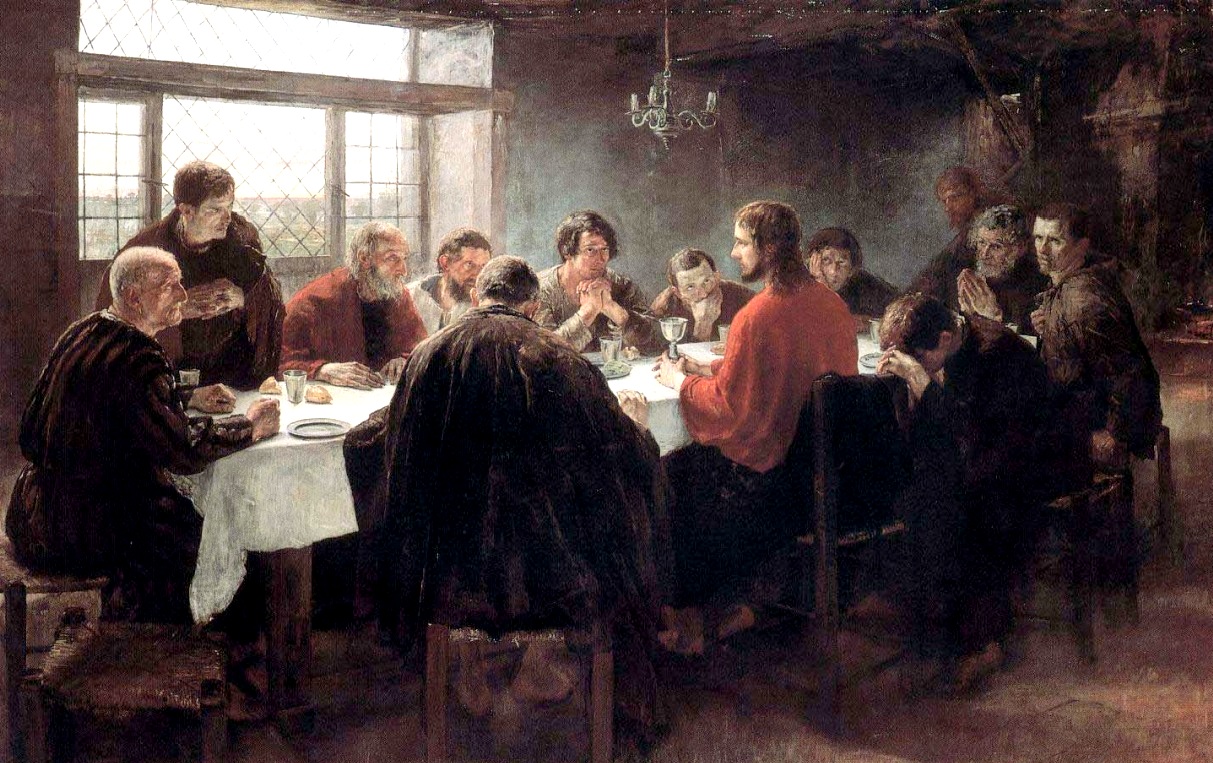 The Last Supper by Fritz von Uhde (1886) |
|
| Prediction of Peter's denial Main article: Denial of Peter In Matthew 26:33–35, Mark 14:29–31, Luke 22:33–34 and John 13:36–8, Jesus predicts that Peter will deny knowledge of him, stating that Peter will disown him three times before the rooster crows the next morning.[46] The three Synoptic Gospels mention that after the arrest of Jesus, Peter denied knowing him three times, but after the third denial, heard the rooster crow and recalled the prediction as Jesus turned to look at him. Peter then began to cry bitterly.[47][48] Elements unique to the Gospel of John See also: Washing the feet of the Apostles, The New Commandment, and Farewell discourse  Jesus giving the Farewell Discourse to his eleven remaining disciples, from the Maesta by Duccio, 1308–1311 John 13 includes the account of the washing the feet of the Apostles by Jesus before the meal.[49] In this episode, Apostle Peter objects and does not want to allow Jesus to wash his feet, but Jesus answers him, "Unless I wash you, you have no part with me",[50] after which Peter agrees. In the Gospel of John, after the departure of Judas from the Last Supper, Jesus tells his remaining disciples [51] that he will be with them for only a short time, then gives them a New Commandment, stating:[52][53] "A new command I give you: Love one another. As I have loved you, so you must love one another. By this everyone will know that you are my disciples if you love one another."[54] Two similar statements also appear later in John 15:12: "My command is this: Love each other as I have loved you",[55] and John 15:17: "This is my command: Love each other."[56][53] At the Last Supper in the Gospel of John, Jesus gives an extended sermon to his disciples.[57] This discourse resembles farewell speeches called testaments, in which a father or religious leader, often on the deathbed, leaves instructions for his children or followers.[58] This sermon is referred to as the Farewell discourse of Jesus, and has historically been considered a source of Christian doctrine, particularly on the subject of Christology. John 17:1–26 is generally known as the Farewell Prayer or the High Priestly Prayer, given that it is an intercession for the coming Church.[59] The prayer begins with Jesus's petition for his glorification by the Father, given that completion of his work and continues to an intercession for the success of the works of his disciples and the community of his followers.[59] |
ペテロの否定の予言 主な記事 ペテロの否定 マタイによる福音書26:33-35、マルコによる福音書14:29-31、ルカによる福音書22:33-34、ヨハネによる福音書13:36-8におい て、イエスはペテロがイエスを知っていることを否定することを予言し、ペテロは翌朝のにわとりが鳴く前に3回イエスを見捨てるだろうと述べている [46]。 3つの共観福音書によると、イエスの逮捕後、ペテロはイエスを知っていることを3回否定したが、3回目の否定の後、にわとりが鳴くのを聞き、イエスが彼を 見ようと振り向くと予言を思い出した。その後、ペテロは激しく泣き始めた[47][48]。 ヨハネによる福音書特有の要素 以下も参照: 使徒たちの足を洗う、新しい戒め、別れの講話  11人の弟子たちに別れの言葉を述べるイエス(ドゥッチョ作『マエスタ』より、1308-1311年) ヨハネによる福音書13章には、食事の前にイエスが使徒たちの足を洗ったことが書かれている[49]。このエピソードでは、使徒ペトロがイエスに足を洗わ せたくないと反対するが、イエスは「わたしがあなたがたを洗わなければ、あなたがたはわたしといっしょにいることはできない」と答え[50]、ペトロは同 意する。 ヨハネによる福音書では、最後の晩餐からユダが去った後、イエスは残された弟子たちに[51]、自分が彼らと一緒にいるのはほんの少しの間だけだと告げ、 それから次のように新しい戒めを与える[52][53]: 互いに愛し合いなさい。わたしがあなたがたを愛したように、あなたがたも互いに愛し合いなさい。わたしがあなたがたを愛したように、あなたがたも互いに愛 し合わなければならない」[54]: わたしがあなたがたを愛したように、互いに愛し合いなさい: 互いに愛し合いなさい」[56][53]。 ヨハネによる福音書の最後の晩餐で、イエスは弟子たちに長い説教をする[57]。この説教は、遺言と呼ばれる別れの演説に似ており、父親や宗教的指導者 が、しばしば臨終の床で、自分の子供や信者たちに指示を残すものである[58]。 この説教はイエスの告別説教と呼ばれ、歴史的にキリスト教の教義、特にキリスト論の主題の源とみなされてきた。ヨハネによる福音書17:1-26は、来る べき教会のための執り成しであることから、一般に「別れの祈り」または「大祭司の祈り」として知られている[59]。この祈りは、イエスの御業が完成した ことから、御父によって栄光を与えられるようにというイエスの願いから始まり、弟子たちの業と信者たちの共同体の成功のための執り成しへと続く[59]。 |
| 続きは「歓待 のための最後の晩餐」につづく | 続きは「歓待 のための最後の晩餐」につづく |
Links
Bibliography
Other informations
このページのオリジナル情報は、ダイキン工業株式会社による「基礎検討フェーズ報告書・研究 テーマ提案」から「2020年度共同研究委受託研究」のフィージビリティ調査研究費より支援を受けて作成されました。関係者に深謝します。

Copyleft, CC, Mitzub'ixi Quq Chi'j, 1996-2099
☆
 ☆
☆